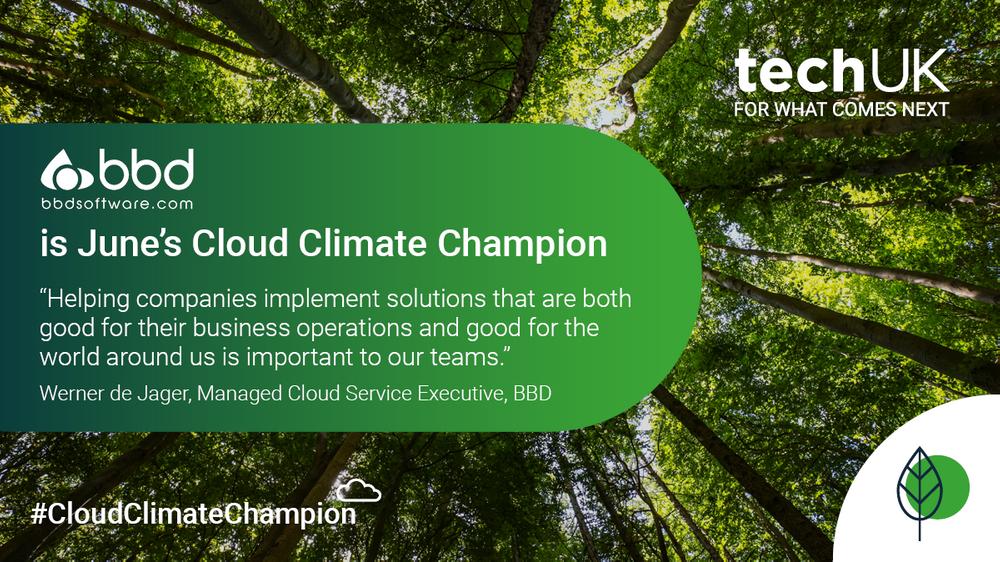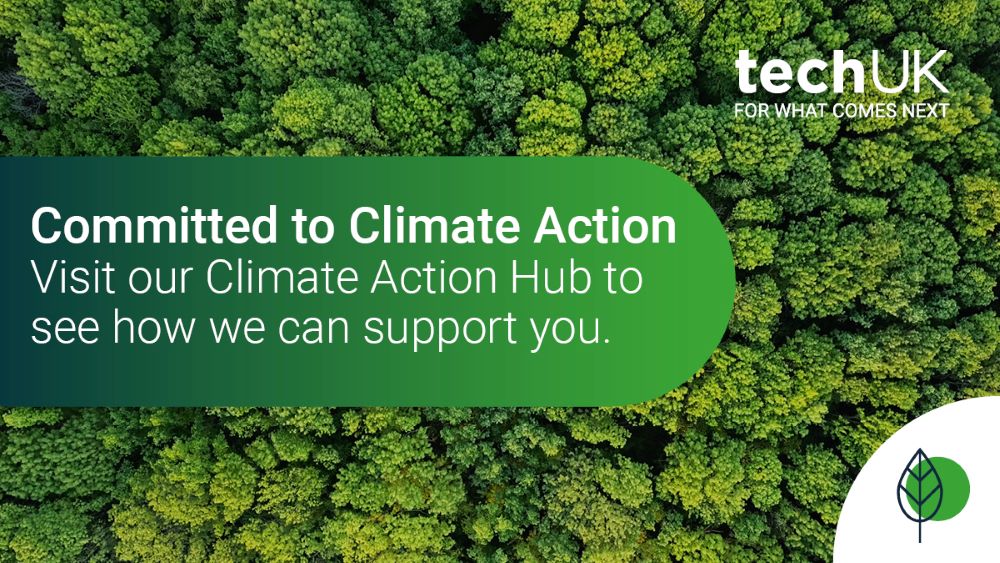More than just the right thing to do - Achieving sustainability with the cloud (Guest blog from BBD)

Author: Werner de Jager, Managed Cloud Service Executive, BBD
On the precipice of irreparable climate change with a global recession knocking on our door, environmental and economic sustainability is being recognised as a critical factor for good business practices as ESG principles take root around the globe.
Wanting to do their part, businesses are looking for ways to contribute towards their ESG goals without disrupting day-to-day operations across their organisation. One such method gaining popularity is by leveraging the cloud.
How the cloud contributes towards sustainability
Popular cloud providers Amazon Web Services (AWS), Microsoft Azure, Oracle and Google Cloud platform (GCP) have all set specific goals to ensure their businesses positively contribute towards global initiatives to improve the state of the environment.
AWS for example has committed to drastically lowering its carbon footprint, aiming to use 100% renewable energy by 2025. Azure is looking to use 100% renewable energy by 2025 and be zero-waste and water positive by 2030. Oracle already has 100% of their European data centres powered by renewable energy, and GCP, already carbon neutral, aims to run on carbon-free energy, 24/7, at all data centres by 2030.
Cementing this move towards sustainable practices, cloud providers are among the top purchasers of renewable technology and energy in the world.
But what does this mean for businesses utilising the cloud?
Businesses utilising the cloud are joining a collective effort to apply good environmental practices inherent to the cloud provider operating models.
In a broad sense, many of the sustainable data centres operated by cloud providers are feeding power back into the grid, offsetting their usage, and helping communities in those areas as well as the planet. But, through the use of shared resources inherent in cloud computing as well as the fact that private and on-premises data centres are becoming a thing of the past, companies are in turn limiting their carbon footprint.
This collective buying when purchasing services from hyper scalers (like GCP or AWS) includes the automatic savings from not having to own equipment for your services to run on, maintain said equipment, or power the environment and resources.
Advancements in virtualisation and software-defined infrastructure also helped make big leaps in decreasing the environmental impact of producing and running physical infrastructure. The rise of hyper scaler services and orchestration capabilities further accelerated this by providing the ability to consume at a micro-transaction level instead of running physical/virtual infrastructure 24/7.
Auto-scaling, serverless technology, and right-sizing are concepts that underpin cloud infrastructure and enable businesses to optimise their energy consumption by utilising only the resources they require in real-time. This ‘modernisation’ approach eliminates wasteful consumption from constantly powering resources catering to potential peak usage.
Buying into these services also means that businesses utilising the cloud are joining a collective effort to apply good environmental practices inherent to the cloud provider operating models.
Another aspect of this is how utilising the cloud can help organisations move towards better business sustainability and continuity – speaking to economic growth and job creation.
How the cloud enables business sustainability
Global market intelligence firm IDC predicts that by 2024, 45% of organisations worldwide will deem business and environmental sustainability considerations to be crucial for their technology buying decisions, and that by 2025, 85% of organisations will see a 35% increase in sustainable efficiencies using software and cloud-related infrastructures.
Another important factor is fault tolerance and disaster recovery (DR) within the cloud. Through various geographic zones and well-designed infrastructure, organisations can leverage these capabilities to ensure their business continues to run smoothly without having to worry about a natural disaster or system failure. This not only brings peace of mind, but an opportunity for businesses to remain sustainable more easily.
Cloud providers also offer services that simplify application deployment automation processes and subsequently eliminate toil, meaning employees can focus on value-driving initiatives rather than repetitive tasks. Not only is this helping spur organisations forward, but it enables businesses to stay competitive while ensuring continuity.
This focus on value-driving tasks has an added benefit. By offloading cloud-related tasks to specialists, businesses can create space for their employees and IT teams to concentrate on more meaningful, purpose-driven work instead of tasks that ‘keep the lights on’. This in turn means employees are more engaged, committed, innovative, and accepting of transformational change as your business continues to grow. Yes, this makes an organisation more sustainable, but it also helps ensure that the people in your charge are happier and more productive.
The three sides of sustainability
Doing our part to help the planet makes each of us feel good, but from a business perspective, sustainability can be looked at from three lenses. The first two we’ve discussed: positively contributing to the global climate crisis, and harnessing the best value your employees can add with good ESG practices and policies that promote value-driven activities. The third relates to the cloud itself: FinOps.
FinOps is a practice where you assess the resources you’re using in the cloud alongside your spending, ultimately seeking to understand how you can either decrease spending leaving your resources utilised untouched, or decreasing the resources used to reduce your overall spending. It fits into the overarching pay-per-use model of the cloud, where you only pay for that which you need, and relates to how well you’ve architected your setup.
The strength of any good building lies in its foundation. Implementing cloud environments requires cloud architects to step in and design a solution that will deliver on expectations and requirements. Architects want efficiency, not only because it makes the cloud environment more effective and efficient, but also because it enables it to be more sustainable in the long run.
So, efficiency equals more sustainability. But how do you do it in practice?
Architecting sustainability
One way is to embed solutions with architectural and FinOps best practices. The AWS Well-Architected Framework has six pillars of focus: operational excellence, security, reliability, performance efficiency, cost optimisation, and sustainability.
The sustainability pillar within the Framework looks at the long-term environmental, economic, and societal impacts of a business’ activities through six design principles and a Well-Architected Review uses these principles to assess and observe where your organisation currently lies. The resultant report is often beneficial when needing to report back on business sustainability.
As a partner who can provide Well-Architected Reviews, our cloud team at BBD use the framework to assess and understand your cloud infrastructure to provide remediation suggestions to make it all more efficient, more cost-effective, and ultimately more sustainable. It’s at this point where we look to modernise or re-engineer using the likes of microservices and containers to squeeze every last drop of efficiency from the cloud for your business. From there, the cycle continues – we observe, remediate, modernise.
Partnering with BBD also ensures you not only have experts assessing and improving your current architecture, but that you have experts maintaining, monitoring, and modernising your multi-or hybrid cloud going forward. Helping companies implement solutions that are both good for their business operations and good for the world around us is important to our teams.
So now?
Whether you’re looking to adopt better practices for the environment, want to motivate your employees, improve business efficiency, or simply need to re-evaluate your spending considering coming economic turmoil, harnessing the cloud may just be the answer.
About BBD
A leading international provider of software development and application design solutions, BBD’s nearly four decades of technical and domain expertise spans the education, financial services, insurance, gaming, telecommunications and public sectors. BBD employs over 1 000+ highly skilled, motivated and experienced IT professionals, with hubs the UK, Netherlands, Portugal, South Africa and India.
If you’re looking for a cloud partner who works with you to understand what solution will be best for your business and strategic goals and then deliver on that, reach out to BBD to learn more on their wide range of cloud services.
As a technologist, how can my software be greener? (Guest blog from Kainos)
techUK - Committed to Climate Action
Visit our Climate Action Hub to learn more or to register for regular updates.
By 2030, digital technology can cut global emissions by 15%. Cloud computing, 5G, AI and IoT have the potential to support dramatic reductions in carbon emissions in sectors such as transport, agriculture, and manufacturing. techUK is working to foster the right policy framework and leadership so we can all play our part. For more information on how techUK can support you, please visit our Climate Action Hub and click ‘contact us’.


